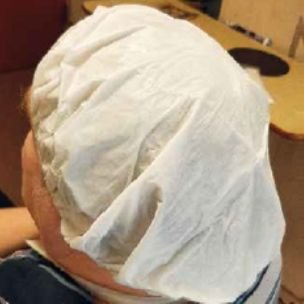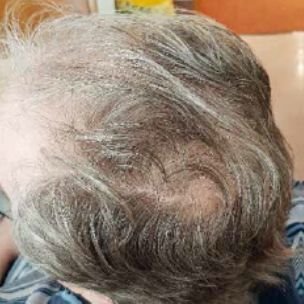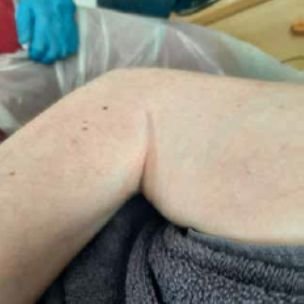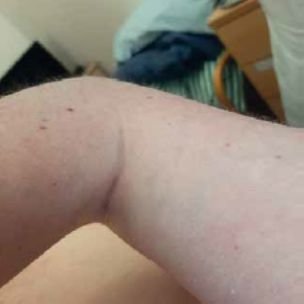
Waterless Bathing for inpatients with neurological issues and complex needs

Waterless Bathing for inpatients with neurological issues and complex needs

Key Points
■ Waterless bathing is more likely to help improve skin conditions compared to traditional soap and water approaches
■ Behavioural issues related to discomfort with traditional bathing methods are alleviated through waterless bathing
■ Pain linked to hypersensitivity and movement is mitigated with waterless bathing techniques
■ Waterless bathing can contribute to cost savings by reducing staff time and the need for medicated creams
■ The reduction in staff time allows them to allocate more time to holistic patient care, enhancing overall outcomes
Article Published in British Journal of Nursing, 2023, Vol 32, No 22
This article explores the introduction of waterless bathing techniques in a specialist hospital for people who have complex medical needs often as a result of acquired brain injury or serious neurological conditions. As dedicated health professionals, our primary goal is to provide the highest standard of care, particularly for patients experiencing neurological challenges.
Traditional soap and washcloth bathing methods can cause discomfort to such patients, which prompted the ward-based nursing teams providing care to investigate the practicality and efficacy of waterless bathing tailored to patients’ individual needs.
In addition to patient comfort, efficient time management is paramount in healthcare. Therefore, the author also looked at whether waterless bathing could save time without compromising patient care.
This study investigated waterless bathing, examining its potential to improve patient experiences while upholding the highest standards of healthcare. Four case studies are used to evaluate and demonstrate the application of these techniques.
Hospital-acquired infections
Hospital-acquired infections (HAIs) persist as a pressing concern within the NHS (National Institute for Health and Care Excellence, 2016). These infections can arise from medical procedures, surgical interventions or mere exposure to pathogens within healthcare facilities.
The spectrum of HAIs encompasses urinary tract infections, surgical site infections, bloodstream infections and ventilator associated pneumonia, among others. Their consequences of HAIs are profound, including patient pain and distress, prolonged hospital stays, the need for additional medical interventions and potentially long-term health repercussions. HAIs also impose substantial financial burdens on the NHS.
The cost of treating infections contracted within healthcare settings is substantial, contributing to the NHS’s ever-expanding financial pressures. Moreover, HAIs intertwine with the global concern of antibiotic resistance, a major health threat highlighted by the World Health Organization (2022). Antibiotic resistance increases the length and number of hospital stays, healthcare expenses and mortality rates. Averting and controlling HAIs are paramount not only for patient wellbeing but also for the NHS’s operational sustainability.
Limitations of traditional bed-bathing
Traditional bed-bathing practices involving soap and water, while widespread, have several inherent shortcomings.
Standard soap, which often contains sodium laureth sulfate, effectively eliminates dirt and grease from the skin. However, when it is not rinsed off adequately, it can provoke skin irritation and, in some instances, precipitate conditions such as dermatitis, eczema, causing discomfort to both patients and health professionals (Branco, 2005).
Additionally, the use of reusable basins and traditional laundering methods carry the risk of cross-contamination. The laundering process can be financially burdensome, particularly when high-temperature washing is required to sustain infection prevention and control measures.
The time required for traditional bed-bathing with soap and water can also put a strain on healthcare staff resources. Nurses must allocate substantial time for this task, potentially to the detriment of other patient-related activities.
Bathing vulnerable patients
When administering care, especially to individuals with cognitive impairments or other vulnerabilities, several pivotal considerations come into play. Primarily, patient participation in their care should be encouraged whenever feasible. Informed and voluntary involvement fosters a sense of autonomy and empowerment among patients. Dignity and comfort are paramount during bathing.
Considering these issues are especially important for patients with cognitive issues such as dementia who may be more susceptible to confusion or distress during personal care routines.
Health professionals must approach these individuals with compassion and understanding (Nursing and Midwifery Council, 2018). Furthermore, personal care moments, including bathing, offer a unique opportunity for healthcare staff to forge rapport with patients. These interactions can yield valuable insights into a patient’s needs and preferences, aiding in the tailoring of care plans to suit individual requirements.
Skincare should be integrated into bathing, particularly for patients with restricted mobility who may be at heightened risk of pressure damage or moisture-associated skin problems. Healthcare staff must conduct comprehensive inspections, identifying potential problem areas and actively addressing them.
Conti® waterless bathing products
Conti® waterless bathing departs from traditional bed bathing methods as the products cleanse the skin leaving it as clean as if traditional soap and water has been used. This approach revolves around the use of waterless products, notably bedbathing washcloths and rinse-free shampoo caps.
The bed-bathing washcloths come individually packaged and are designed for single use, significantly diminishing the risk of cross-infection. They are pH balanced and dermatologically tested, ensuring compatibility with diverse skin types and conditions. These washcloths are not only highly effective, but also gentle, affording comfort to patients, particularly those with neurological disorders who may find traditional bathing methods distressing.
Another product is a rinse-free shampoo cap. Placed on the head of a patient who is confined to bed, it securely confines their hair. Through gentle massaging, the cap lathers up and absorbs oil and dirt from the scalp, leaving the hair feeling soft, fresh and almost towel dried. This solution eliminates the need for water, enhancing patient comfort and streamlining the shampooing process.
Advantages of waterless bathing
The transition from traditional bed-bathing methods to waterless solutions such as Conti® offers numerous advantages.
First, it fortifies infection prevention and control. Single-use products significantly reduce the risk of cross-infection, a pivotal benefit for immunocompromised patients or those in isolation because of infectious ailments. This not only shields the patient, but also safeguards health professionals and other patients in close proximity.
Furthermore, waterless bathing methods are economic, saving valuable healthcare staff time. Traditional methods often necessitate extensive preparation, laundering and patient mobilisation. With waterless solutions, patients can remain comfortably in their rooms, obviating the need for transfers to showers or baths. This not only optimises nursing time but also trims expenses linked to patient mobilisation and handling, such as the need for analgesics as there is less pain stemming from fewer movements.
Patients are likely to have better dignity and privacy, and an overall enhanced experience. They can uphold their sense of autonomy and comfort throughout the process, resulting in a more positive care encounter.
In summary, the adoption of Conti® waterless bathing solutions constitutes a comprehensive enhancement in the patient experience, infection control and operational efficiency within healthcare facilities.
Case studies
These four case studies describe the results when traditional soap-and-water bathing carried out at the author’s hospital was replaced with Conti®’s waterless approach. All four studies were run for 1 week. The patients’ names are pseudonyms.
Case study 1. Patient comfort and staff time
Mr Smith* is a 60-year-old man who has an acquired brain injury following a basal ganglia intracranial haemorrhage. He can communicate his basic needs and preferences verbally but becomes impatient and frustrated with conventional bedbathing and showering techniques. Additionally, he experiences intermittent skin redness in his groin area, partly attributable to incontinence and his aversion to using urinary sheaths.
This case study aims to evaluate the potential benefits of waterless bathing on Mr Smith’s wellbeing. The objectives were to: assess whether waterless bathing improved Mr Smith’s behaviour and skin condition; and measure its impact on staff time, especially on allocated shower days.
Methods
Waterless bathing washcloths and shampoo caps were selected to replace traditional soap and water methods. Vernacare recommends using 10 wipes for each wash episode. Wipes and caps were warmed in advance to enhance patient comfort.
Mr Smith was briefed about the study and gave his verbal consent.
Observations
■ Mr Smith immediately noticed the softness and comfort of the wipes
■ Initially, he was hesitant about the shampoo cap but became comfortable once it had been placed properly
■ His behaviour improved notably; he appreciated the speedier bathing process, enabling him to have his breakfast sooner, which was important to him
■ Having no water near his tracheostomy increased the safety of the hair-washing process.
Staff feedback
Staff reported that the experience was overwhelmingly positive and facilitated a smoother, quicker bathing process. They noted visible improvements in the redness in Mr Smith’s groin area and an overall improvement in his behaviour.
The adoption of waterless bathing methods led to enhanced patient satisfaction, behavioural changes and safety, particularly regarding the tracheostomy. Staff also reported an overall positive experience, indicating that this method could be considered for wider adoption in similar patient care scenarios.

Shampoo cap in situ.

Hair looking clean after being washed with a rinse free shampoo cap
Case study 2. Skin conditions and odour in a patient in a minimally conscious state
Mr Peters* is a 47-year-old man who sustained a hypoxic brain injury after an asthma attack led to cardiopulmonary arrest. He remains in a minimally conscious state with no meaningful responses.
He has severe upper and lower limb contractures, resulting in persistent skin-on-skin redness and soreness, suspected to be intertriginous dermatitis. Traditional soap and water methods have been difficult in managing his skin condition and odours effectively.
The objectives were to: determine whether waterless bathing improved skin conditions in and around Mr Peters’ contracted joints; and to assess its impact on reducing unpleasant odours emanating from difficult-to-reach skin folds.
Methods
The study employed waterless bathing washcloths and shampoo caps, using 10 wipes per wash episode, as recommended by Vernacare. These were warmed before use for added patient comfort. Consent for the change in bathing method was obtained from Mr Peter's next of kin.
Observations
■ Mr Peters appeared calm and comfortable when washed with the waterless washcloths and shampoo cap
■ Staff noted significant improvements in odour from previously hard-to-reach areas
■ Red and sore skin areas showed improvement after careful washing and drying with the washcloths.
Staff feedback
The washcloths were particularly effective for cleaning areas that were difficult to reach because of Mr Peters’ limb contractures, such as his hands and groins.
Staff reported that the washcloths were softer and more malleable than traditional flannels, making the cleaning process easier.
Unlike after traditional bathing, Mr Peters’ skin remained in a good condition and did not appear dry.
Waterless bathing showed promising results in improving skin conditions and reducing unpleasant odours.
Staff feedback was overwhelmingly positive, highlighting ease of use and effectiveness. Given these results, waterless bathing methods could be considered for similar clinical scenarios.

Redness in elbow crease before starting waterless bathing

Skin starting to improve after doing waterless bathing for 1 week
Case study 3. Pain management in a patient with C3 cord compression
Mr Fowler* is a 72-year-old man diagnosed with C3 cord compression.
Because of his condition, he experiences generalised hypersensitivity when touched, causing him extreme pain— particularly in his neck—during conventional bed bathing and showering. He has full mental capacity and consented to the study.
The primary aim was to evaluate whether waterless bathing methods could reduce his generalised pain, subsequently lessening his need for analgesics during personal care. The objectives were to: determine whether waterless bathing reduced
Mr Fowler’s generalised pain; and assess if waterless bathing could decrease his reliance on as-needed analgesia, thus improving his quality of life.
Methods
Both waterless bathing washcloths and caps were used for this case study. They were warmed before use for added patient comfort. Mr Fowler gave his consent for this alternative bathing approach.
Observations
■ Mr Fowler reported significantly lower pain levels while using waterless bathing methods
■ Except for day 4, he did not require analgesia during the study, although it was offered
■ He experienced lower levels of anxiety overall
■ The waterless shampoo cap was particularly helpful in reducing neck pain
■ No water entering his tracheostomy stoma or ventilator circuit improved the safety of the whole process.
Staff feedback
The staff found the waterless bathing method to be a safer and more effective way of managing Mr Fowler’s hypersensitivity and pain, particularly given the added safety around his tracheostomy and ventilator circuit.
Waterless bathing appears to offer significant benefits for Mr Fowler, notably in reducing his generalised pain and anxiety, while also providing improving safety.
Given these outcomes, this bathing method warrants consideration for wider application in managing patients with similar conditions.

Case study 4. Agitation and dermatitis following multiple intracranial haemorrhages
Mr Macky* is a 60-year-old man diagnosed with left temporal intracranial haemorrhage, frontal lobe subarachnoid haemorrhage with midline shift and right cerebral vascular accident.
He presents with involuntary movements, presumably owing to agitation during personal care. These movements involve limb contractions and grabbing tubes, which complicate the washing process. He has persistent redness in his groin area from incontinence-associated and intertriginous dermatitis.
The objectives were to: evaluate whether waterless bathing methods reduced Mr Macky’s agitation; and assess the impact of waterless bathing on the persistent redness and dermatitis in his groin area.
Methods
For this case study, waterless washcloths and shampoo caps, warmed before use, were to be employed. The aim was to minimise agitation while improving the condition of Mr Macky’s skin.
Observations
■ There was a slight improvement in the long-standing redness and irritation in Mr Macky’s groin and scrotum area
■ Although the study duration was only 1 week, it was speculated that continued use could lead to further improvements in skin condition.
Staff feedback
The healthcare team reported the process as being easier to manage, given Mr Macky’s tendency for involuntary movements and agitation. The waterless method also reduced the risks associated with his grabbing of tubes, including that of his catheter bag.
Conclusion
These findings strongly suggest that waterless bathing techniquesoffer considerable advantages in specialist neurological hospital settings.
In case study 1, behavioural challenges were significantly reduced, leading to a calmer patient experience, less stress for staff and more efficient use of carer time. This shift could potentially reduce the need for medication for behavioural management in the long term. The absence of water also enhanced patient safety by minimising the risk of aspiration, which was particularly important for this patient as he had a tracheostomy.
In case study 2, although the changes in skin condition were subtle because of the limitations of the study period, there was a notable reduction in unpleasant odours. The design of the waterless wipes made them especially effective in reaching tight skin areas. Prolonged use could likely improve skin health furtherand reduce the necessity for medicated creams, saving both time and financial resources.
Case 3 demonstrated immediate benefits in reducing pain and hypersensitivity, contributing to a decrease in the need for as-needed medication. This improvement not only enhances the patient’s quality of life but also allows healthcare staff to reallocate time to other aspects of patient care.
Case 4 provided encouraging initial results. Although improvements in skin condition were subtle, staff anticipate that extending the use of waterless bathing products would lead to ongoing improvement in the patient’s dermatological health.
Overall, staff observed significant gains in patient comfort, satisfaction and dignity. The reduction in behavioural issues and pain in cases 1 and 3 were particularly striking. Efficiency gains were also noted, as staff time saved could be redirected towards other beneficial patient interactions, addressing not just physical but also social and psychological needs.
Staff highly recommend the adoption of Vernacare’s Conti® waterless bathing products in a broad range of healthcare scenarios. They have the potential to improve behavioural issues, pain management and skin health, while also offering cost efficiency advantages.
References:
Branco N, Lee I, Zhai H, Maibach HI. Long-term repetitive sodium lauryl sulfate-induced irritation of the skin: an in vivo study. Contact Dermatitis. 2005;53(5):278-784. https://doi.org/10.1111/j.0105-1873.2005.00703.x]
National Institute for Health and Care Excellence. Healthcare-associated infections. Quality standard. 2016. https://www.nice.org.uk/guidance/ qs113 (accessed 30 October 2023)
Nursing and Midwifery Council. The code. Professional standards of practice and behaviour for nurses, midwives and nursing associates. 2018. https://www.nmc.org.uk/code/ (accessed 30 October 2023)
World Health Organization. WHO launches first ever global report on infection prevention and control. Press release. 6 May 2022. https://tinyurl. com/57ur23a4 (accessed 30 October 2023)

Find out more about the Conti® Waterless Bathing Range
View more information, the full range of products, plus access key resources.
Find out more